The causes of child poverty are tragically varied. Without essentials like clean water, nutritious food, education, healthcare or safe shelter, a child is considered impoverished. Lacking even one of these basics is a violation of a child’s rights. It can change a young life forever.
In 2019, child poverty was affecting some
1.1 billion girls and boys worldwide. Global efforts were gradually reducing child poverty numbers. Yet
one in six of the world’s children was still struggling to survive on an average
$1.90 per day or less per person.
Since 2020, the causes of child poverty began including the effects of the COVID-19 pandemic.
Globally, extreme poverty is increasing, for the first time in more than 20 years. By September 2020, an estimated 150 million additional children had been plunged into poverty
due to COVID-19. And that number is growing.
In this article, you’ll learn where childhood poverty is most dire, within Canada and around the world. We’ll explain why impoverished children suffer more than adults. You’ll learn how child poverty can impact families for generations to come – and how COVID-19 is intensifying the crisis.
- What are the causes of child poverty?
- Why are children more impacted by poverty?
- How bad is child poverty in Canada?
- Where in the world is child poverty most dire?
- What about child poverty in other fragile regions?
- How is COVID-19 worsening child poverty everywhere?
- Can child poverty ever be reduced or eradicated altogether?
- How can I help combat child poverty?
1. What are the causes of child poverty?
There are no cookie-cutter examples of child poverty, either in Canada or around the world. Looking at the two basic approaches to measuring child poverty can help us understand some of its causes:
‘Monetary child poverty’: a financial measure
According to the World Bank, children facing monetary poverty live in households struggling to survive on an average of US$1.90 per day or less per person. To calculate monetary child poverty on a national scale, factors such as a country’s GDP and average per capita income are considered.
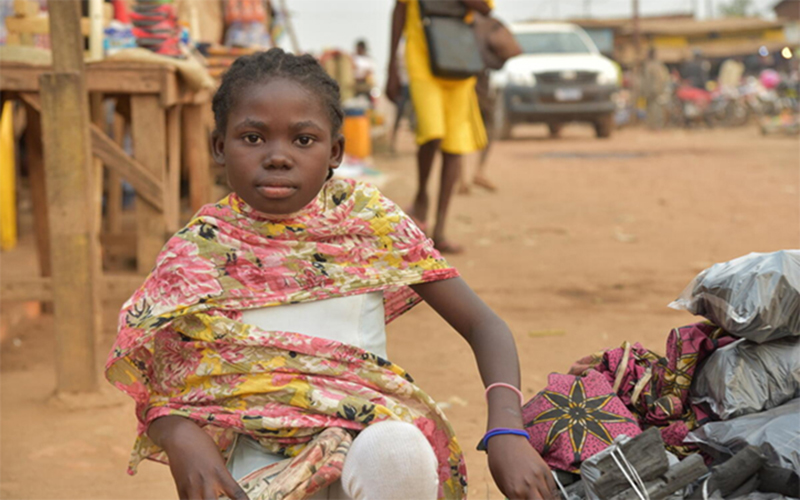 Sourcevie pays for her own schooling by selling coals in the market when she’s not in class. Even primary education in the Democratic Republic of Congo is not free. Photo: Patrick Abega
Sourcevie pays for her own schooling by selling coals in the market when she’s not in class. Even primary education in the Democratic Republic of Congo is not free. Photo: Patrick Abega
Monetary child poverty is made so much worse for children in regions with limited infrastructure and scant social safety nets. Lack of free education, for example, can affect every aspect of a child’s life if her parents don’t earn enough to pay school fees.
‘Multidimensional child poverty’: a more comprehensive measure
Although measures such as household income are important, they provide
only a partial view of the realities, says UNICEF. A multidimensional approach is essential to understanding both the causes of child poverty and its effects.
‘Multidimensional child poverty’ factors in critical basics such as nutritious food, clean water and sanitation, housing and education. These essentials are fundamental, not only for a child’s development, but for the fulfillment of their human rights.
By this definition:
- Child poverty can exist even in situations where parents have saved money, but children have no school or clean water within walking distance. Without them, children’s needs aren’t met, and their rights aren’t fulfilled.
- Child poverty may not exist in families where parents are unemployed but receive social assistance and children have things like clean water and sanitation, healthy food, safe housing and education.
When families in Canada lose jobs, social safety nets often play an important role in keeping children out of poverty. The typical causes of child poverty have less power with social programs in place.
Contrast that with children living in South Sudan or Afghanistan, for instance. Income alone can’t prevent child poverty in regions where kids face multiple threats. Without safety nets, factors like climate change, food crisis, collapsed economies and bombed schools can plunge children deep into poverty.
In Afghanistan, for example,
56 per cent of children live in multidimensional child poverty caused by climate change, food crises, a poor economy, violent conflict and displacement.
2. Why are children more impacted by poverty?
Girls and boys are born packed with potential. And childhood years are critical opportunities for growth and development. Yet because of this, children also far more vulnerable to the effects of poverty. They’re more likely to suffer today and in the long-term. Some examples:
Child poverty and malnutrition
Children’s minds and bodies are working hard to grow and develop. Poverty contributes to stunting, affecting
one in five children worldwide, with effects lasting a lifetime. Good nutrition can make the difference between
healthy development and stunted development, health and illness, vision and blindness – even life and death. It’s essential to help children succeed in school today and secure better sources of income tomorrow.
Child poverty and clean water
Children need
two to eight cups of clean water per day (depending on age) to drink, as well as other water from foods. When clean water isn’t available, children must resort to water that’s often contaminated. Waterborne illnesses like diarrhea can keep kids from school, causing them to fall behind or even drop out. Diarrhea kills 2,105 children per day, more than AIDS, malaria and measles combined.
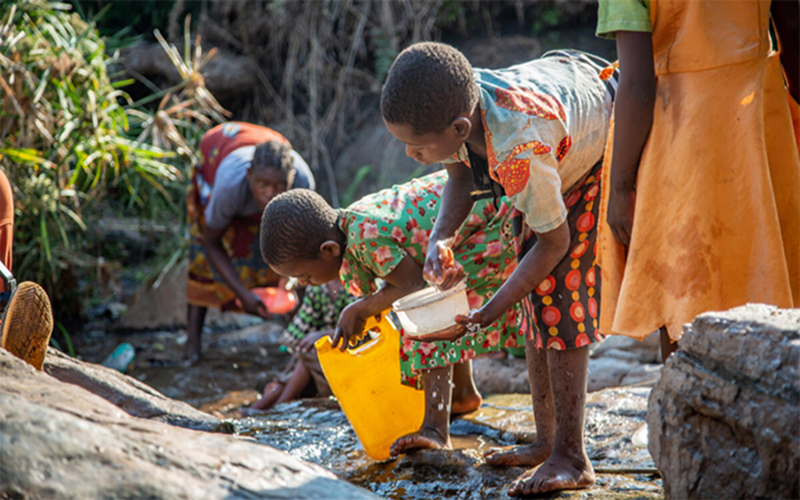 In Malawi, Ireen (green dress) and her friends walk for unclean water two or three times a day – a total of around 6 kilometres. Lack of clean water is one of the causes of child poverty, causing waterborne diseases and missed education. Photo: Atlas Productions
Child poverty and education
In Malawi, Ireen (green dress) and her friends walk for unclean water two or three times a day – a total of around 6 kilometres. Lack of clean water is one of the causes of child poverty, causing waterborne diseases and missed education. Photo: Atlas Productions
Child poverty and education
Children need education to develop today and thrive tomorrow. In many regions of the world, education is a once-in-a-lifetime opportunity. Disruptions to a child’s education – like persistent illness, civil conflict or a global pandemic can affect children’s prospects forever.
COVID-19 has caused the most severe disruption to global education systems in history, forcing more than
1.6 billion learners out of school. In impoverished regions with no online learning, this could mark the end to many children’s education.
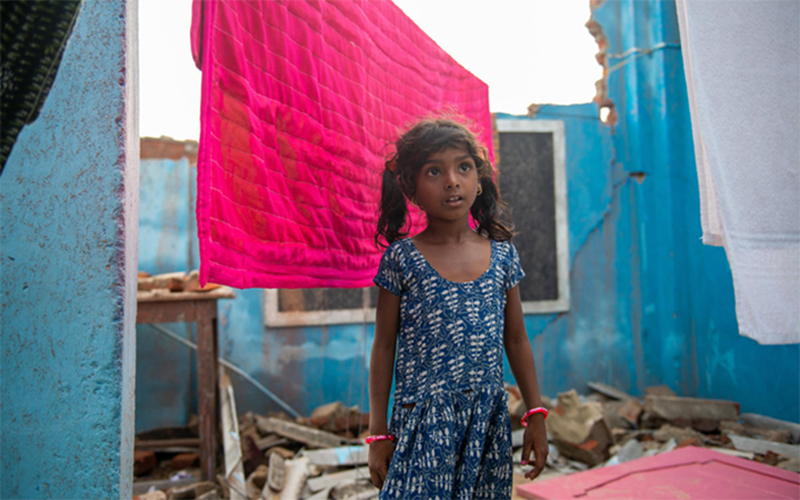 In India, a girl stands outside the ruins of her school, destroyed by Cyclone Fani in 2019. Climate change is intensifying natural disasters, especially in some of the world’s poorest regions. It can take months or years to rebuild school buildings, meaning children fall behind. Photo: Jim Kasom
Child poverty and safe shelter
In India, a girl stands outside the ruins of her school, destroyed by Cyclone Fani in 2019. Climate change is intensifying natural disasters, especially in some of the world’s poorest regions. It can take months or years to rebuild school buildings, meaning children fall behind. Photo: Jim Kasom
Child poverty and safe shelter
Children need safe shelter to grow up healthy in body, mind and spirit. Without it, children are more vulnerable on every level. Children are smaller, physically weaker with underdeveloped immune systems.
Exposure to rain, cold, unrelenting heat, as well as the threats of physical or sexual attack, places children in grave danger. At least
28 million children are homeless, due to global conflict.
Child poverty and healthcare
Children need access to health and medical care, to stay healthy or receive treatment for illness. They need the adults around them to receive basic health education so they can make sound caregiving decisions.
Without these things
, children may suffer from deficiencies, dangerous traditional practices or untreated illness.
Half the world lacks access to basic health services, according to the World Bank, with millions of children among them.
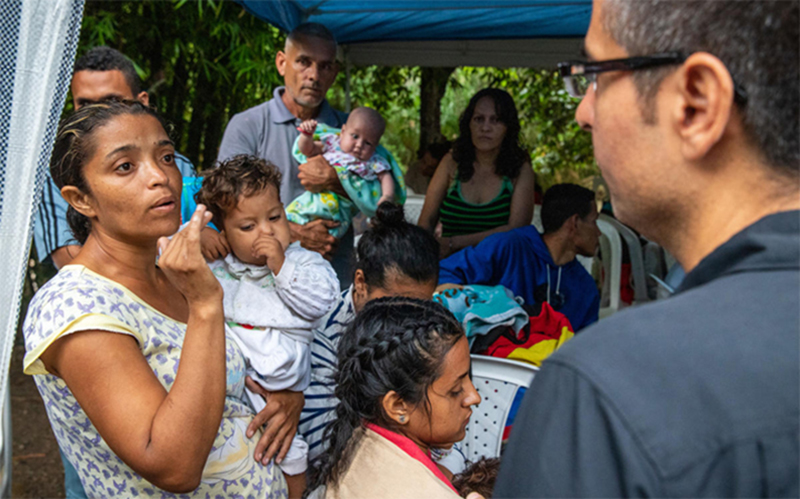 In Venezuela, the double-crisis of economic collapse and COVID-19 means families often can’t afford food – let alone pay medical bills. The health system is collapsing leaving millions of children without medical care. Many have fled to neighbouring Colombia. Photo: Chris Huber
Child poverty and protection
In Venezuela, the double-crisis of economic collapse and COVID-19 means families often can’t afford food – let alone pay medical bills. The health system is collapsing leaving millions of children without medical care. Many have fled to neighbouring Colombia. Photo: Chris Huber
Child poverty and protection
Children are entitled to fully live out their childhoods. But in situations of extreme poverty, children may be shoved into adult situations. A staggering
73 million children work in dangerous or exploitative conditions, some as young as five.
Each year, an estimated
12 million girls are forced to marry against their will, long before their young minds and bodies are ready.
In child marriage, girls may suffer from:
- forced sexual intercourse and pregnancy before their young bodies are developed
- death during pregnancy or childbirth.
- physical, sexual and emotional abuse
- end of education as the bride leaves school to care for her husband and children
- enduring poverty for the wife and her children, as she is unable to finish school and secure a good income
3. How bad is child poverty in Canada?
As wealthier nations, you may think Canada would be child-poverty free. Yet
one in every five girls and boys in Canada lives in poverty – that’s
more than 560,000 children. Indigenous, immigrant or racialized (marginalized or categorized according to race) children are drastically and disproportionately affected.
As a result, while only
12 per cent of non-Indigenous, non-immigrant, non-racialized children in Canada are impoverished:
- 53 per cent of status First Nation children on reserves – and 41 per cent of those off-reserve – live in poverty
- 25 per cent of Inuit children live in poverty
- 22 per cent of Metis children live in poverty
- 32 per cent of non-status First Nation children live in poverty
- 35 per cent of former or current landed immigrant or permanent resident children live in poverty
- 22 per cent of racialized children in Canada live in poverty
Child poverty in your community
Child poverty isn’t always something you can see. Children at your local school may not eat until dinnertime, if not for the school breakfast program. The family on the bus beside you may not be able to afford heating this month.
In 2018, Census data indicated that ten municipal wards in the city of Toronto had a shocking child poverty rate of between 33 and 47 per cent. Families in rural communities may struggle to provide the necessities of life for their children
due to a lack of employment or affordable childcare.
4. Where in the world is child poverty most dire?
Over three-quarters of the world’s impoverished children live in Africa, placing the continent at the centre of the global fight against child poverty.
According to the Brookings Institution:
- Africa’s rapid population growth, younger population and larger families push up child poverty rates across the continent.
- Families with more children tend to be poorer. And today, almost every second baby worldwide is being born into an African family.
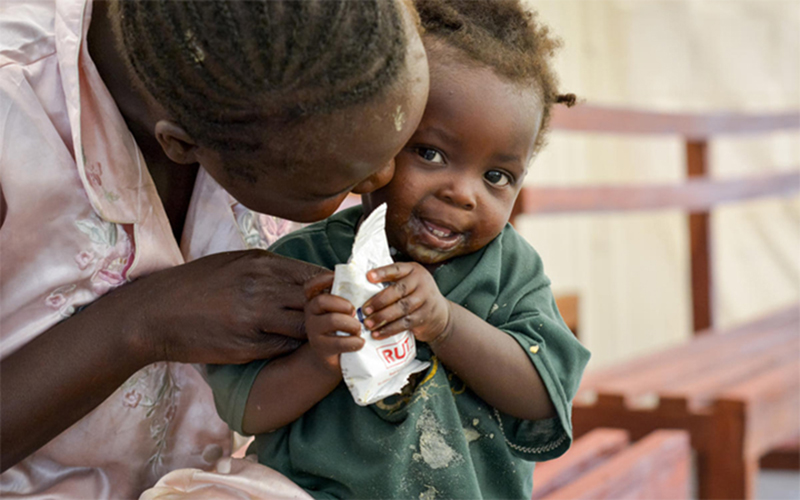 There’s enough love to go around. But millions of growing families in sub-Saharan Africa struggle to secure essentials like nutritious food for their children. Photo: Mark Nonkes
There’s enough love to go around. But millions of growing families in sub-Saharan Africa struggle to secure essentials like nutritious food for their children. Photo: Mark Nonkes
The situation in sub-Saharan Africa is especially acute, with
two-thirds of all children facing extreme poverty. This poverty is multi-faceted and highly complex. Children in regions of the Central African Republic, Congo, Somalia and South Sudan might be simultaneously:
- displaced from their homes by violent conflict
- malnourished due to food crisis brought on by climate change
- suffering from waterborne disease due to lack of clean water
- lacking education as they live on the run
- without basic healthcare as their countries’ systems collapse
5. What about child poverty in other fragile regions?
Globally, an estimated 800 million children live in fragile and conflict-affected areas. They’re
the world’s most dangerous places, fraught with chronic instability, conflict and violence. A fragile region might comprise the lion’s share of an entire country – or a smaller pocket within a country.
Large numbers of people in fragile areas are trapped in cycles of desperation and poverty. Children are most drastically affected. Some examples:
- Hunger and malnutrition – When societies and economies are unstable, it can be impossible for families to grow or source enough nutritious food for their children. The situation grows more dire as food prices soar.
- Dangerous water – When natural disasters or armed conflict destroys wells, pumps and standpipes and lakes and rivers dry up, children often have no source of clean water close to home. Many are forced to drink contaminated water, causing disease and even death.
- Exploitation, abuse and neglect – When parents struggle to meet their children’s basic needs, kids may end up in desperate, dangerous situations. Children may be abused or exploited, in the community and even within the home.
6. How is COVID-19 worsening child poverty everywhere?
The effects of the global pandemic are making matters worse everywhere, but especially in poor and middle-income regions.
- The economic crises in countries around the world threatens to hit children and families the hardest, says UNICEF.
- As livelihoods are destroyed and unemployment increases, millions more families are pushed below national poverty lines.
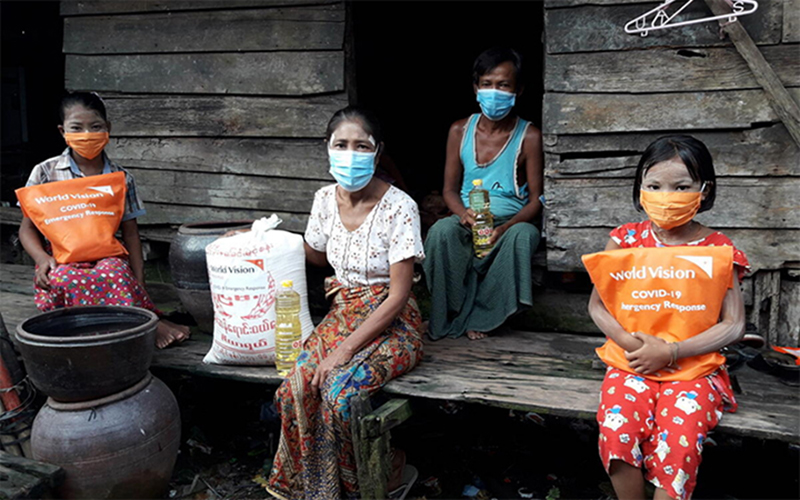 In Myanmar, experts predicted up to 2.1 million COVID-related job losses in 2020 alone. Thandar (right) was begging on the streets to help her family. World Vision is now supporting them with a variety of nutritious food ingredients. Photo: Phoebe Naw
In Myanmar, experts predicted up to 2.1 million COVID-related job losses in 2020 alone. Thandar (right) was begging on the streets to help her family. World Vision is now supporting them with a variety of nutritious food ingredients. Photo: Phoebe Naw
The number of children living in multidimensional poverty
may soar to 1.2 billion as a result of the pandemic, says UNICEF.
COVID-19 and Canadian child poverty
In 2020, government transfers to Canadian families helped prevent child poverty in many homes and neighbourhoods. But UNICEF has predicted that
child poverty will rise above pre-COVID levels for at least five years, in high-income countries like Canada.
Alberta, reports that job losses and pandemic-related disruptions have increased child poverty in the province. Children in single-parent households were more likely to experience poverty, with
some 50 per cent living below the province’s low-income threshold.
7. Can child poverty ever be reduced or eradicated altogether?
The global pandemic is the real game-changer here. The situation for children living in multidimensional
child poverty is likely to worsen. That’s unless national government and the international community step up to soften the blow.
Organizations like the World Bank, the United Nations, World Vision and others – combined with national governments around the world – have shown that child poverty is not inevitable. Pre-COVID, steps taken to address it were often highly successful.
But attention must be rigorous and ongoing, note all parties. Organizations like the World Health Organization have weighed in on different approaches. Most parties agree that:
- We must not focus on the 2030 of the Sustainable Development Goals without considering the more immediate needs created by COVID-19
- We must be vigilant about predicting and planning for the evolving needs of children facing poverty with all its faces
- We must advocate for children facing poverty in the world’s toughest places, particularly as wealthier countries focus on their own coronavirus challenges
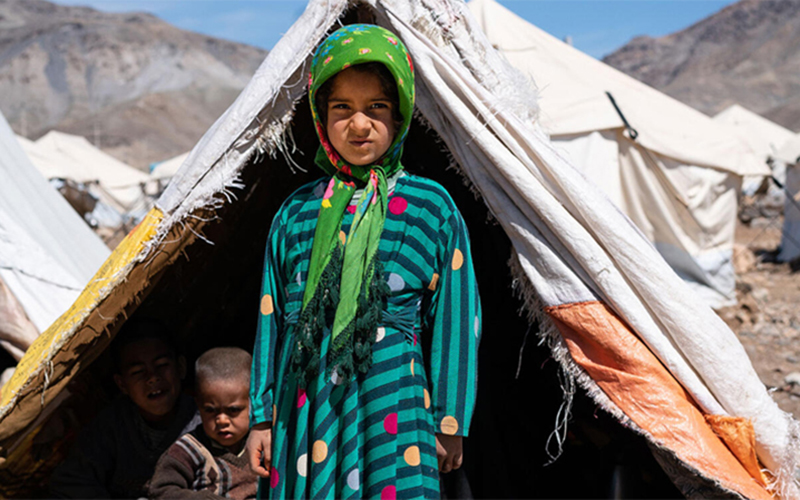 In western Afghanistan, a devastating drought in 2018-2019 displaced hundreds of thousands of people from their homes. Parents are desperately seeking food for their families. As always, children suffer the most. Photo: Brett Tarver
In western Afghanistan, a devastating drought in 2018-2019 displaced hundreds of thousands of people from their homes. Parents are desperately seeking food for their families. As always, children suffer the most. Photo: Brett Tarver
In our
Aftershocks report, World Vision has noted that the pandemic threatens to impact the lives of millions of children – drastically and even irreversibly. Some examples are child marriage or entering dangerous, exploitative jobs.
“Without immediate action to protect people’s livelihoods now, the impact of this pandemic will reverse progress toward the Sustainable Development Goals, and irreparably damage the lives of current and future generations of children,” noted the report’s authors.
8. How can I help combat child poverty?
Whether the children on your mind are in your community, your country or thousands of kilometres away, there are many ways you can help – even during COVID 19. Here are some suggestions:
- Get creative for your local food bank! Many grocery stores or fire stations have drop-off points. Many food banks also accept donations themselves.
- Stay connected with your community, to see where the needs are. Check on families with children to see if they need food, clothing or a bit of financial help.
- Support families you know who are new to English. Children’s parents might need assistance securing support from schools or government agencies.
- Raise funds for impoverished children in developing countries, through distanced events like World Vision’s distanced Global 6K for Water.
- Advocate for children facing poverty, in your community, across Canada and around the world. Reach out to Canadian organizations supporting Indigenous families, for instance, to see what’s needed.
- Donate to World Vision’s gift catalogue, which continues to help Canadians fight global child poverty even during COVID-19. Choose from clean water, nutrition, education, livelihood or health gifts. In some cases, your donation multiplies, thanks to partnership with the World Food Programme or the Canadian government.